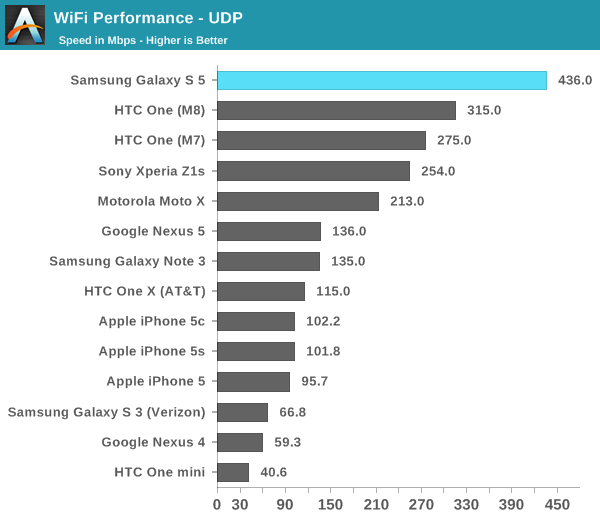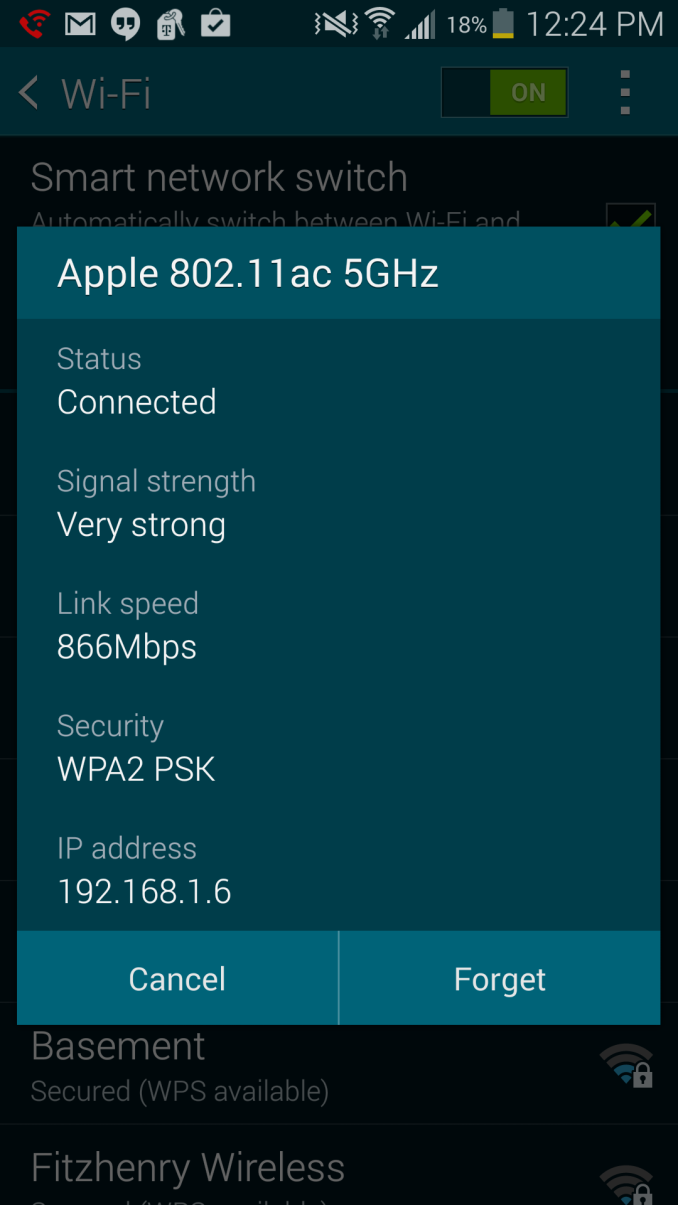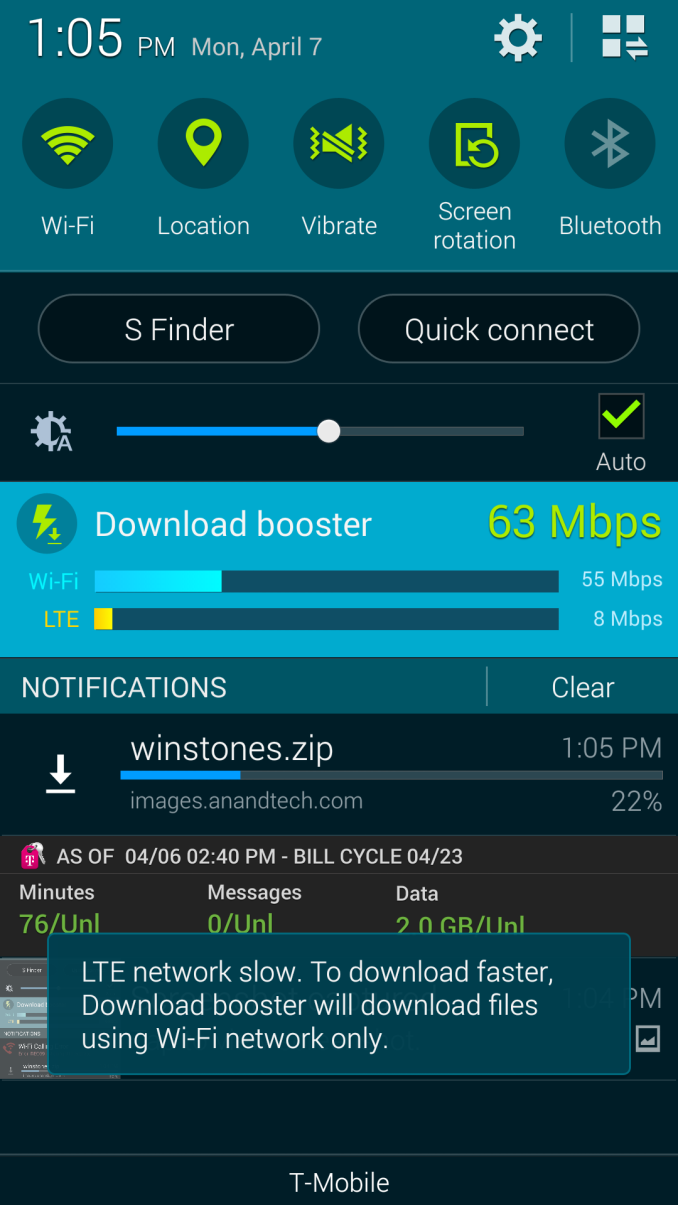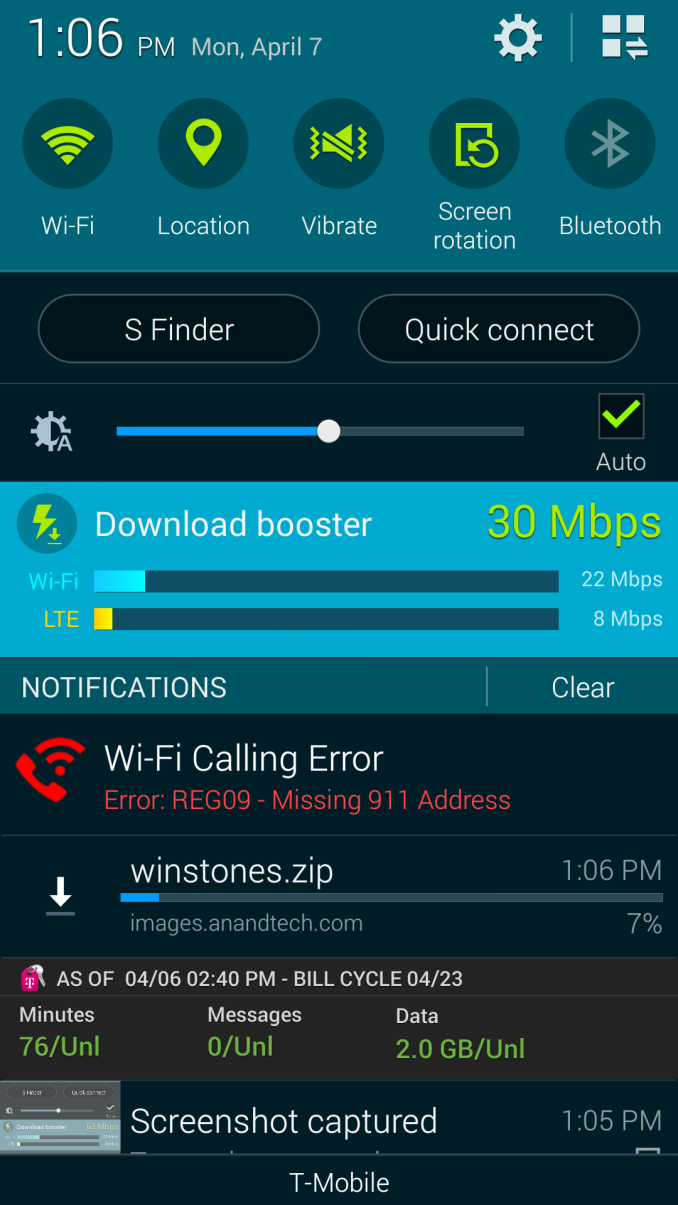Samsung Galaxy S 5 Review
by Anand Lal Shimpi & Joshua Ho on April 8, 2014 12:00 AM EST- Posted in
- Smartphones
- Samsung
- Mobile
- Galaxy S 5
WiFi, Cellular & Download Booster
At MWC this year Broadcom announced its BCM4354 802.11ac 2x2 MIMO WiFi combo chip for smartphones/tablets, which found its way into the GS5. The result is a smartphone capable of negotiating with an 802.11ac AP at 867Mbps, and transferring data at up to 436Mbps.
Although peak performance is nice, there are also power benefits to being able to transfer data quickly over WiFi (race to sleep applies to network interfaces as well).

The Snapdragon 801 features Qualcomm's integrated category 4 LTE 9x25 modem core. As I mentioned in our power analysis, Samsung also chose to include Qualcomm's QFE1100 envelope tracker (just like in the Galaxy Note 3). The GS5 is also the first flagship Samsung device to include support for 2 carrier aggregation on supported LTE networks. Samsung doesn't appear to be using Qualcomm's antenna tuner or any other RF360 components in the Galaxy S 5.
Seamless transition between network interfaces is one component of Qualcomm's vision of the future of connected devices. The problem is presently more of a software one than a hardware challenge. Samsung is beginning to explore software abstraction of underlying network interfaces with the GS5's software stack. There's now an option to prevent transitioning to WiFi networks that don't offer an improved network experience compared to your broadband connection. I haven't had a ton of time to test this feature out yet but it's something I plan on messing with more over the coming weeks.
The other big feature is what Samsung is calling Download booster. If enabled and under the right conditions, download booster allows you to combine WiFi and cellular network interfaces to accelerate large file downloads. All you have to do is enable download booster and you'll get a notification if it's active and working:
Download booster uses HTTP range requests to divide up files between the two network links. The feature can migrate data sessions from one link to another (WiFi to LTE, LTE to WiFi). Supported apps include the Play Store, YouTube, Facebook photo/video downloads, Samsung apps and standard HTTP web browsing (both Samsung's own browser and third party browsers). FTP and UDP aren't supported, nor is HTTPS.
There are other limitations as well. File downloads smaller than 30MB won't trigger download booster. Similarly, if one of the interfaces is substantially faster than the other download booster won't activate either. My home internet connection can regularly pull files down at 50 - 60Mbps, compared to < 10Mbps for T-Mobile LTE. When I was getting ~7Mbps over LTE and 50Mbps over WiFi, download booster automatically turned itself off. If I throttled my home network to 22Mbps however, download booster did its thing and gave me a healthy combined download speed of 30Mbps.
Download booster is a neat feature, although of limited use for those of us without truly unlimited high speed data plans. That being said, if you need to speed up a download in a pinch it's a great way to do that. I'm often at a press event wanting to download a benchmark onto a device as quickly as possible, usually without great WiFi or cellular reception - I can see download booster being very useful there at least.













296 Comments
View All Comments
Thermogenic - Tuesday, April 8, 2014 - link
It's a shame that Nokia picture samples aren't included in comparison. Either Lumia 1020, 1520, or Icon (930). Heck, even an older 920/925 would be adequate.StevoLincolnite - Tuesday, April 8, 2014 - link
Yeah I wouldn't mind a Lumia being included in the comparisons, then we can see how every platform stacks up in these reviews.inighthawki - Tuesday, April 8, 2014 - link
On top of that it would be nice to see the results of at least some windows phones on the graphs. I can understand that a lot of windows phones have lower end hardware because they aren't very resource intensive, and thus probably don't always top the benchmarks, but it would be nice to know how they compare. Even if it's just a single entry at the bottom as an "FYI"mtoma - Tuesday, April 8, 2014 - link
I believe the review lacks the comparison with Windows 8 phones, because this site has no reviews with ANY Windows 8 phone. It just avoids them. At least Brian Klug did that. So, if he's not around, the better the things will be. Let's see if anything changes here. In the mean time, as far as smarthpones goes, I read mainly other sites.coburn_c - Tuesday, April 8, 2014 - link
Doesn't the Sony use the same camera hardware?melgross - Tuesday, April 8, 2014 - link
Did you read the whole review? If you did, you would have read that this is Samsung's own sensor this year.kyuu - Tuesday, April 8, 2014 - link
Yeah, I'm curious if Anandtech is still going to ignore Windows Phone entirely (as far as full-length reviews go) as it has since the WP8 was initially released. I guess time will tell.wrkingclass_hero - Tuesday, April 8, 2014 - link
Did Brian Klug leave? I haven't seen anything written by him in a while, and his twitter hasn't been updated.BMNify - Tuesday, April 8, 2014 - link
yeah, good to see that Brian Klug is no longer writing for Anandtech, he personally hated Windows phones and used to mock them publically. Also, there was no review for Nokia phones eventhough Nokia sent all the flagship models last year like 920,925, 1020 to Brian Klug.And from what i can make out this fiasco has led to Nokia no longer inviting Anandtech to their events and no samples too, hopefully Anand or the new writers can restore the relationship.
Myrandex - Wednesday, April 9, 2014 - link
Yea I agree they seem to ignore that platform completely. They reviewed the HTC 8X but that is the last I saw out of AT here.